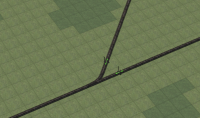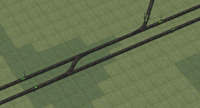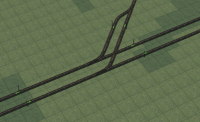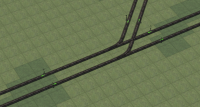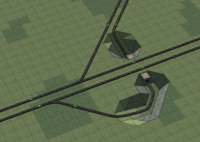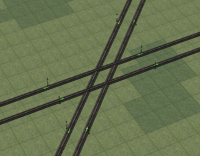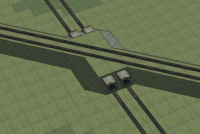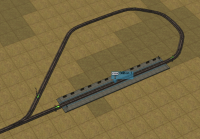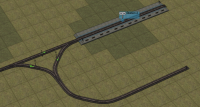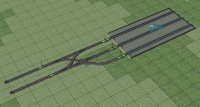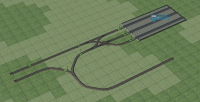Difference between revisions of "Junctions"
(→Terminus Junctions) |
|||
| Line 93: | Line 93: | ||
==Terminus Junctions== | ==Terminus Junctions== | ||
| − | These are a selection of junctions that go at the end of a railway line, these are | + | These are a selection of junctions that go at the end of a railway line, these are designed for both high capacity and the ability to turn the trains around to prevent the locomotives from reversing on their return journey. The max number of trains refers the number of trains can use the station without a risk of causing a blockage. All stations below can have their capacity increased by placing block [[signals]]. |
{| class="wikitable" | {| class="wikitable" | ||
| Line 100: | Line 100: | ||
! Information | ! Information | ||
! Signalling Complexity | ! Signalling Complexity | ||
| + | ! Max No. of trains | ||
! No. of Points | ! No. of Points | ||
! No. of Crossings | ! No. of Crossings | ||
| Line 107: | Line 108: | ||
| A simple method of turning around trains at the end of the line. | | A simple method of turning around trains at the end of the line. | ||
| Low | | Low | ||
| + | | 2 | ||
| 1 | | 1 | ||
| 0 | | 0 | ||
| Line 114: | Line 116: | ||
| An alternative method of turning around trains at the end of the line. | | An alternative method of turning around trains at the end of the line. | ||
| Medium | | Medium | ||
| + | | 2 | ||
| 3 | | 3 | ||
| 0 | | 0 | ||
| Line 121: | Line 124: | ||
| An advanced version of the return loop, this version allows multiple lines to feed into a single station. One way signals must be used to allow for continuous flow. | | An advanced version of the return loop, this version allows multiple lines to feed into a single station. One way signals must be used to allow for continuous flow. | ||
| High | | High | ||
| + | | n | ||
| 3 x n | | 3 x n | ||
| 0 | | 0 | ||
| Line 126: | Line 130: | ||
| [[File:Junction_Turminums.png|200px]] | | [[File:Junction_Turminums.png|200px]] | ||
| Main Terminus | | Main Terminus | ||
| − | | A high capacity railway station that works with a continuous supply of trains. There is no reversing facilities, therefore best used when reversing trains are disabled. | + | | A high capacity railway station that works with a continuous supply of trains. There is no reversing facilities, therefore best used when reversing trains are disabled. Further signaling can be added to increase the capacity of the Station beyond a 3 train limit. |
| Medium | | Medium | ||
| + | | 3 | ||
| 7 | | 7 | ||
| 2 | | 2 | ||
| Line 133: | Line 138: | ||
| [[File:Junction_Turminums_With_Triangle.png|200px]] | | [[File:Junction_Turminums_With_Triangle.png|200px]] | ||
| Main Terminus with Turning Triangle | | Main Terminus with Turning Triangle | ||
| − | | A variation of the Terminus station with reversing facilities | + | | A variation of the Terminus station with reversing facilities. Further signaling can be added to increase the capacity of the Station beyond a 3 train limit. |
| High | | High | ||
| + | | 3 | ||
| 8 | | 8 | ||
| 2 | | 2 | ||
Revision as of 23:46, 2 November 2017
Game Manual
- Basics
- Game content
- Infrastructure
 Railways
Railways
- Signals
- Junctions
 Roadways
Roadways Airports
Airports Landscaping
Landscaping Electrification
Electrification
- Vehicles
All the exaples below have the basic signaling shown on the images, better signalling positions can improve their preformance if nessesary.
Y Junctions
Y-Junctions act as a convergence or divergence points between two routes on a railway line. Simple solutions tend to work well, but tend to have significant drawbacks when used at high capacity.
Crossings
These are for locations on the tracks where two lines must cross over each other, with no tracked connection between the two.
Terminus Junctions
These are a selection of junctions that go at the end of a railway line, these are designed for both high capacity and the ability to turn the trains around to prevent the locomotives from reversing on their return journey. The max number of trains refers the number of trains can use the station without a risk of causing a blockage. All stations below can have their capacity increased by placing block signals.
